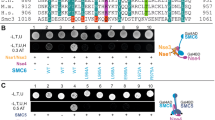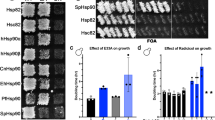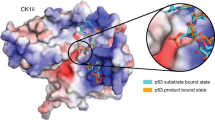Abstract
c-Mos is a germ cell-specific MAP kinase kinase kinase (MAPKKK) that plays an essential role during meiotic divisions of oocytes. c-Mos is a key component of an activity, cytostatic factor, required for metaphase II arrest of unfertilized eggs in vertebrates. To understand the regulation of c-Mos, we are investigating c-Mos-interacting proteins. We provide evidence that mouse c-Mos binds to Hsp70, a molecular chaperone. Hsp70 was found to associate with Mos ectopically expressed in COS-1 cells. Mos-Hsp70 complexes could be immunoprecipitated with both Mos and Hsp70 antibodies. Despite a low-abundance of Mos, the Hsp70 antibody immunoprecipitated Mos as the major protein. Of importance, the Mos protein present in anti-Hsp70 immunoprecipitates functioned as an active MAPKKK indicating that it is not grossly misfolded. It is known that c-Mos protein kinase activity in cell extracts of transfected COS-1 or NIH3T3 cells is labile. We found that the inclusion of adenosine triphosphate (ATP) in cell extracts protected against the loss of Mos kinase activity. In the absence of ATP from cell extracts, protein kinase activity of Mos was lost within 6 h on ice even though the Mos protein was not degraded and remained bound to Hsp70. Based on our identification of c-Mos-Hsp70 interaction, one of the roles of ATP may be to assist the regulation of c-Mos via ATP involvement in the protein-folding function of Hsp70 and possibly other molecular chaperones. We also detected by co-immunoprecipitation a physical association between endogenous c-Mos and Hsp70 in Xenopus eggs. To provide further evidence for the functional significance of Hsp70 interaction to Mos function, we show that the residue serine 3 in Mos, which is important for the regulation of protein kinase activity of Mos is also important for Hsp70 association.
This is a preview of subscription content, access via your institution
Access options
Subscribe to this journal
Receive 50 print issues and online access
$259.00 per year
only $5.18 per issue
Buy this article
- Purchase on Springer Link
- Instant access to full article PDF
Prices may be subject to local taxes which are calculated during checkout










Similar content being viewed by others
References
Aligue R, Akhavan-Niak H and Russell P. . 1994 EMBO J. 13: 6099–6106.
Bai W, Singh B, Yang Y and Arlinghaus RB. . 1992a Oncogene 7: 1757–1763.
Bai W, Singh B, Yang Y, Ramagli LS, Nash M, Herzog NK and Arlinghaus RB. . 1992b Oncogene 7: 493–500.
Bai W, Arlinghaus RB and Singh B. . 1993 Oncogene 8: 2207–2212.
Blair DG, Oskarsson M, Wood TB, McClements WL, Fischinger PJ and Vande Woude GF. . 1981 Science 21: 941–943.
Bukau B, Hesterkamp T and Luirink J. . 1996 Trends Cell Biol. 6: 480–486.
Chen M and Cooper JC. . 1995 Mol. Cell. Biol. 15: 4727–4734.
Chen M, Li D, Krebs EG and Cooper JA. . 1997 Mol. Cell. Biol. 17: 1904–1912.
Colledge WW, Carlton MBL, Udy GB and Evans MJ. . 1994 Nature 370: 65–68.
Dix DJ, Allen JW, Collins BW, Mori C, Nakamura N, Poorman-Allen P, Goulding EH and Eddy EM. . 1996 Proc. Natl. Acad. Sci. USA 93: 3264–3268.
Freeman RS, Kanki JP, Ballantyne SM, Pikham KM and Donoghue DJ. . 1990 J. Cell Biol. 111: 533–541.
Freeman RS, Meyer AN, Li J and Donoghue DJ. . 1992 J. Cell Biol. 116: 725–735.
Frydman J and Höhfeld J. . 1997 Trends Biochem. Sci. 22: 87–92.
Hannink M and Donoghue DJ. . 1985 Proc. Natl. Acad. Sci. USA 82: 7894–7898.
Hartl FU. . 1996 Nature 381: 571–580.
Hashimoto N, Watanabe N, Furuta Y, Tamemoto H, Sagata N, Yokoyama M, Okazaki K, Nagayoshi M, Takeda N, Ikawa Y and Aizawa S. . 1994 Nature 370: 68–71.
Maxwell SA and Arlinghaus RB. . 1985a J. Gen. Virol. 66: 2135–2146.
Maxwell SA and Arlinghaus RB. . 1985b Virology 143: 321–333.
Nebreda AR and Hunt T. . 1993 EMBO J. 12: 1979–1986.
Nishizawa M, Furuno N, Okazaki K, Tanaka H, Ogawa Y and Sagata N. . 1993 EMBO J. 12: 4021–4027.
Nishizawa M, Okazaki K, Furuno N, Watanabe N and Sagata N. . 1992 EMBO J. 11: 2433–2446.
Papkoff J, Verma IM and Hunter T. . 1982 Cell 29: 417–426.
Pennisi E. . 1996 Science 274: 1613–1614.
Pham CD, Arlinghaus RB, Zheng C-F, Guan K-L and Singh B. . 1995 Oncogene 10: 1683–1688.
Pham CD, Rungta M, Chandler DS, Yang Y, Arlinghaus RB, Rajagopalan S, Schwartz MR and Singh B. . 1997 Int. J. Gynecol. Cancer 7: 314–317.
Posada JN, Yew N, Ahn NG, Vande Woude GF and Cooper JA. . 1993 Mol. Cell. Biol. 13: 2546–2553.
Rassow J, von Ahsen O, Bömer U and Pfanner N. . 1997 Trends Cell Biol. 7: 129–133.
Sagata N, Watanabe N, Vande Woude GF and Ikawa Y. . 1989 Nature 342: 512–518.
Sambrook J, Fritsch EF and Maniatis T. . 1989 Molecular cloning: a laboratory manual. Cold Spring Harbor Laboratory Press, Cold Spring Harbor, NY.
Schulte TW, Blagosklonny MV, Ingui C and Neckers L. . 1995 J. Biol. Chem. 270: 585–588.
Shibuya EK and Masui Y. . 1988 Dev. Biol. 192: 253–264.
Shibuya EK and Masui Y. . 1989 Development 106: 799–808.
Singh B, Al-Bagdadi F, Liu J and Arlinghaus RB. . 1990 Virology 178: 535–542.
Singh B and Arlinghaus RB. . 1997 In: Meijer L, Guidet S and Philippe M, (eds). Progress in Cell Cycle Research Vol 3. Plenum Press: New York, USA. Chapter 20 pp. 251–259.
Singh B, Hannink M, Donoghue DJ and Arlinghaus RB. . 1986 J. Virol. 60: 1148–1152.
Singh B, Herzog NK, Liu J and Arlinghaus RB. . 1988 Oncogene 3: 79–85.
Stancato LF, Chow Y-H, Hutchison KA, Perdew GH, Jove R and Pratt WB. . 1993 J. Biol. Chem. 268: 21711–21716.
Stepanova L, Leng X, Parker SB and Harper JW. . 1996 Genes Dev. 10: 1491–1502.
Uzawa M, Grams J, Madden B, Toft D and Salisbury JL. . 1995 Dev. Biol. 171: 512–559.
van Beveren C, van Straaten F, Galleshaw JA and Verma IM. . 1981 Cell 27: 97–108.
Wang XM, Yew N, Peloquin G, Vande Woude GF and Borisy GG. . 1994 Proc. Natl. Acad. Sci. USA 91: 8329–8333.
Xu Y and Lindquist SL. . 1993 Proc. Natl. Acad. Sci. USA 90: 7074–7078.
Yang Y, Herrmann CH, Arlinghaus RB and Singh B. . 1996 Mol. Cell. Biol. 16: 800–809.
Yang Y, Pham CD, Vuyyuru VB, Liu H, Arlinghaus RB and Singh B. . 1998 J. Biol. Chem. 273: 15946–15953.
Zhou R, Daar I, Ferris DK, White G, Paules RS and Vande Woude G. . 1992 Mol. Cell. Biol. 12: 3583–3589.
Zhou R, Oskarsson M, Paules RS, Schultz N, Cleveland D and Vande Woude GF. . 1991a Science 251: 671–675.
Zhou R, Rulong S, da Silva PP and Vande Woude GF. . 1991b Cell Growth Differ. 2: 257–265.
Acknowledgements
We thank D Toft (Mayo Clinic Foundation, Rochester, MN, USA) for providing the BB70 Hsp70 antibody, RB Arlinghaus for suggestions and critical reading of the manuscript, L Feldman for editorial corrections and L Kimbrough for her help in manuscript preparation. This work was supported by the grants R01 CA45125 and CA16672 (core) from the National Institutes of Health.
Author information
Authors and Affiliations
Rights and permissions
About this article
Cite this article
Liu, H., Vuyyuru, V., Pham, C. et al. Evidence of an interaction between Mos and Hsp70: a role of the Mos residue serine 3 in mediating Hsp70 association. Oncogene 18, 3461–3470 (1999). https://doi.org/10.1038/sj.onc.1202699
Received:
Revised:
Accepted:
Published:
Issue Date:
DOI: https://doi.org/10.1038/sj.onc.1202699



